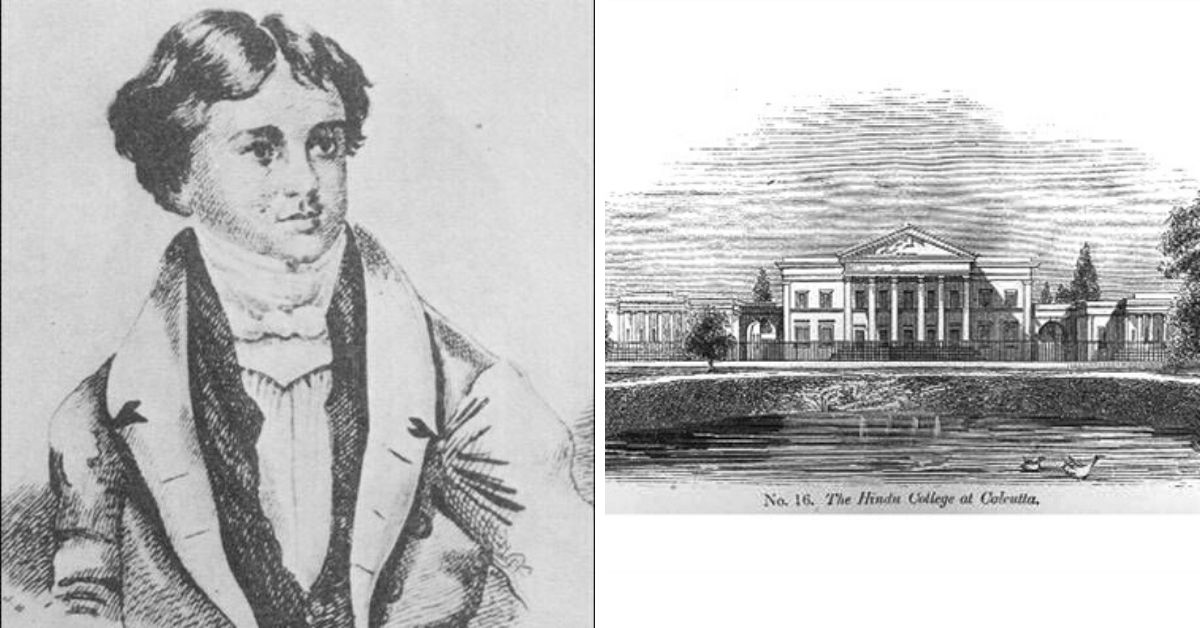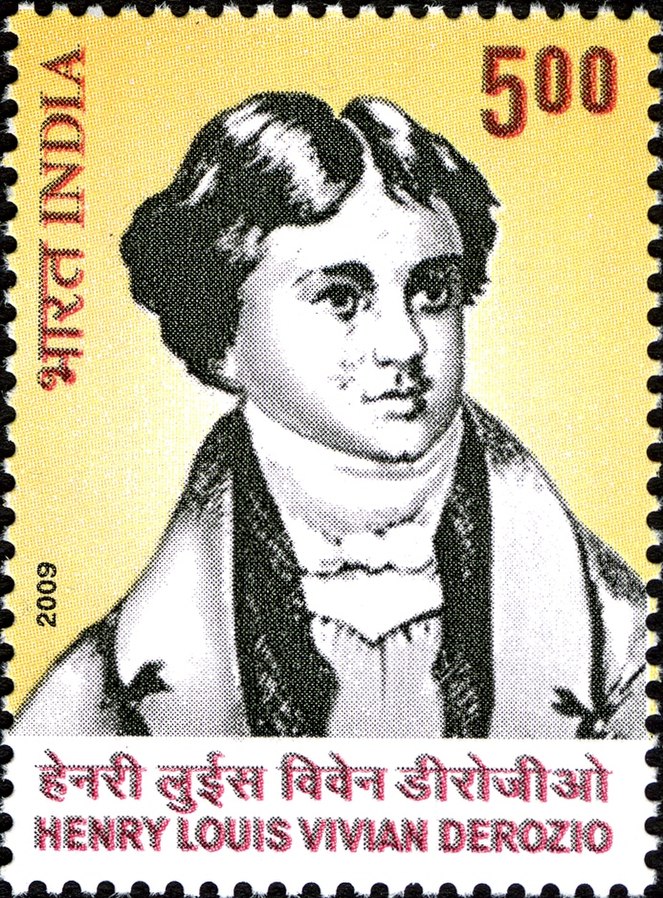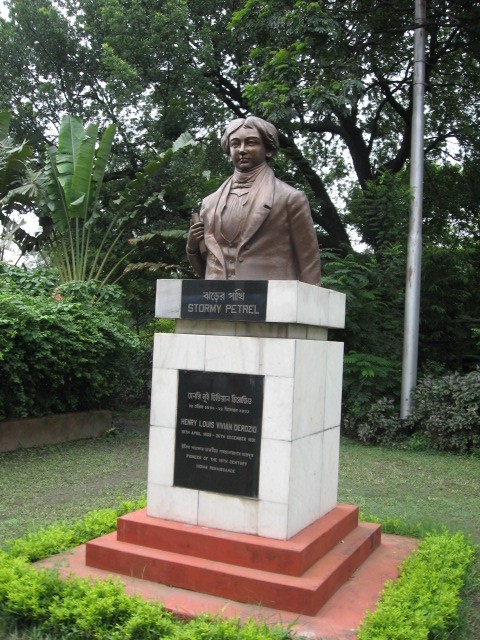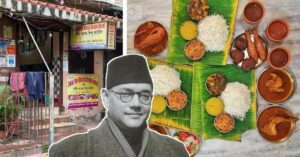First to Use ‘Hinglish’, This Forgotten Writer Helped Spark the ‘Bengal Renaissance’
He was just 23, but he inspired a following that included Bengal's first novelist, and the mathematician who calculated the height of Everest.

With The Positive Collective, The Better India’s COVID-19 coverage is available to regional language publications for free. Write to [email protected] for more details.
In April 1831, a bunch of Calcutta’s notables, bhadralok in local parlance, all managing committee members of Hindu College (later, Presidency College and now, Presidency University), met. They had to decide the fate of a young professor in the educational institution they ran—a young man who was part-Portuguese, part-English, and part-Indian. This young man, barely twenty-two, it appeared, was inciting his students to rebel.
He had encouraged them to eat beef, mock idol-worship, refuse to wear the sacred thread, and in general, ask far too many questions about tradition and authority. An enfant terrible he had turned out to be, and his students were turning out to be his carbon copies.
Such a terrible influence this professor was, that one of his students was caught reciting the lines of Homer’s Iliad, instead of Vedic verses at a religious ceremony.
At this meeting, besides the bhadralok, of whom the most prominent was Ram Comul Sen, the grandfather of Keshab Chandra Sen (a prominent Brahmo Samaj leader in the late 19th century), two Britishers were also present. David Hare was a businessman, educationist, and philanthropist of early 19th century Calcutta. Horace Hayman Wilson, a doctor by training, was the other. He was a champion of Indian learning and had translated the Rigveda and other works to English.
The bhadralok was adamant. Henry Louis Vivian Derozio had to go. They could not countenance his continuance in the institution.

Hare and Wilson may have demurred internally but did not make their feelings known. They did not wish to interfere in a matter that seemed to have raised the hackles of Indian feelings.
Wilson communicated the decision to Derozio. Derozio offered his resignation, but defended his conduct and pointed out that he had been given no opportunity to defend himself.
Wilson then wrote him another letter in which he sought clarification if Derozio was an atheist, if he had encouraged his students to disobey their parents, and whether he approved of incest between brother and sister.
Clearly, these were among the charges that had resulted in his dismissal. Derozio denied these charges vehemently and insisted that he had been sacrificed not on account of these false charges, but because of the bigotry of the committee members.
Thus ended the teaching career of one of early colonial Bengal’s most intriguing cultural figures.
***
Henry Louis Vivian Derozio was born to Francis Derozio and Sophie Johnson Derozio in April 1809. Francis’s father, Michael, was a Portuguese businessman and his mother (whose name is lost to history) was an Indian woman. Sophie, who died in 1815, was an Englishwoman.
As a young lad growing up in a Calcutta that was a significant city in the British universe, Derozio attended the Dhurrumtollah Academy, a school founded by a Scotsman, David Drummond.
Drummond, who arrived in Calcutta in 1813, was something of an iconoclast. A rationalist and sceptic, he instilled the spirit of freethinking in Derozio. He also drilled in him the importance of seeking evidence and reason and not to accept tradition and authority blindly.
For eight years, between the ages of six and fourteen, Derozio was at Drummond’s school and imbibed his bent of mind. Cricket, drama, and English literature were his interests at school, and before he had turned thirteen, he had published his first poem in the India Gazette in 1822.
Leaving school at fourteen, Derozio worked in a clerical position at the firm where his father was employed, but at the age of sixteen, went to Bhagalpur (in modern-day Bihar) to become an indigo planter. Entranced by the countryside, he began writing prodigiously. His poems, all published under the nom de plume of ‘Juvenis’, caught the attention of John Grant, the editor of the India Gazette. He offered to publish them and invited Derozio back to Calcutta. Derozio’s first collection, Poems, was published in 1827.
In 1828, Derozio returned to Calcutta and was appointed professor of English and History at Hindu College. That same year, The Fakeer of Jungheera, A Metrical Tale and Other Poems was published.
Derozio was now recognised as a local literary star, at least among the English-speaking community in Bengal. Even in faraway Britain, the second collection was noticed. Thomas Campbell, a minor literary figure, reviewed the book favourably and commented on the promise that Derozio held since he was just eighteen when the collection had appeared.
Objectively speaking, Derozio’s poetry, while promising, is of limited literary interest today. Derived from English metrical forms and striving to ape the prevalent English style of the day, the poems are not particularly original. Of interest is the fact that Derozio consciously identified as ‘Indian’ and chose Indian themes for his writing. The Harp of India is a poem that laments India and her lost glories as does To India: My Native Land.
The Fakeer of Jungheera, a poem of 2,050 lines, is a tragic inter-religious love story that blends Hindu, Islamic, and Christian symbols. And in the process of writing poetry that was rooted in Indian consciousness, Derozio created, what many agree, the first published example of Hinglish:
Without thy dreams, dear opium,
Without a single hope I am,
Spicy scent, delusive joy,
Chillum hither lao, my boy! (italics mine)
From ‘Ode—from the Persian of Half’ Queez’
Derozio also wrote essays which have aged better. They are well-written in themes that range from aesthetics to social change, carefully chosen and researched.
But, Derozio’s greatest contribution was in his short career as a teacher at Hindu College.

He stressed the virtue of freethinking to his students, many of whom were only a few years younger than himself; he encouraged them to question, speak up, and read widely beyond the curriculum. A small bunch of students were spellbound and became extremely devoted to him, visiting his home frequently, where they held discussions on a variety of matters.
In his sonnet, To the Pupils of the Hindu College, Derozio recorded his delight at what he had inspired:
Expanding like the petals of young flowers
I watch the gentle opening of your minds,
And the sweet loosening of the spell that binds
Your intellectual energies and powers
That stretch (like young birds in soft summer hours)
Their wings to try their strength.
Derozio also founded a discussion group, ‘Academic Association’, which met frequently. While most of its members were his students, among the others who turned up for its sessions was David Hare. The Derozians, as many of the students who belonged to this group came to be known, included Peary Chand Mitra, who later became a prominent writer and journalist (he wrote Alaler Gharer Dulal, one of the first novels in Bengali) and Radhanath Sikdar, the mathematician who calculated the height of the Mount Everest using trigonometric methods.
While Homer, Milton, Shakespeare and others were, of course, read, as part of the curriculum, under Derozio’s influence, the students also began reading the works of Voltaire, Kant, Paine and the Romantic poets of England. Shelley, in particular, was a huge favourite and something of his rebelliousness found its way to the students.
Hindu orthodoxy became a prime target, and Derozians began to indulge in behaviour that came to be seen as scandalous—refusal to wear the sacred thread, opposing idolatry, and beef consumption.
Soon, the rumours flew thick and fast among Calcutta’s bhadralok. The students, it was whispered, had all become atheists, had no respect for their parents, and that they even approved of incest. Also, it was rumoured that Derozio, a Christian, was soon to marry the sister of Dakhinaranjan Mukherjee, a Brahmin and a prominent Derozian.
Soon enough, the knives were out, and Derozio was axed from Hindu College after a short and eventful three years.
He then embarked on a career in journalism, starting a newspaper called the East Indian which sought to become a voice for the Anglo-Indian (then called Eurasian) community. But it was to prove a short one.
In December 1831, not yet twenty-three, he succumbed to cholera.
In life, Derozio had been a divisive figure. In death, at least during the 19th century, this did not change. For years after his death, some Indians uttered his name with contempt. His students and other admirers remained fiercely devoted to his memory and defended him vehemently. His poetry had sparked off a new genre of writing in English by Indians, and through the 19th century, many Indians contributed to this body of writing.
Also Read: Publisher of Ghalib, This Forgotten Pioneer Sparked India’s Love For Printed Books
But more importantly, many Derozians (also known as ‘Young Bengal’) became figures in culture and science, and part of what came to be known as the ‘Bengal Renaissance’. This cultural, social and intellectual movement shaped Bengali society and its intelligentsia.
For a twenty-something, it was a remarkable achievement.
(Edited by Shruti Singhal)
Featured images: Hindu College, Wikimedia Commons
Like this story? Or have something to share?
Write to us: [email protected]
Connect with us on Facebook and Twitter.

Similar Story

Netaji Bose’s Favourite Eatery Has Been Serving Traditional Delicacies for Over 100 Years
The Swadhin Bharat Hindu Hotel in Kolkata, started by Mangobindo Panda, is a century-old pice hotel where Indian freedom fighters like Netaji Subhas Chandra Bose would enjoy Bengali delicacies.
Read more >
If you found our stories insightful, informative, or even just enjoyable, we invite you to consider making a voluntary payment to support the work we do at The Better India. Your contribution helps us continue producing quality content that educates, inspires, and drives positive change.
Choose one of the payment options below for your contribution-
By paying for the stories you value, you directly contribute to sustaining our efforts focused on making a difference in the world. Together, let's ensure that impactful stories continue to be told and shared, enriching lives and communities alike.
Thank you for your support. Here are some frequently asked questions you might find helpful to know why you are contributing?


This story made me
-
97
-
121
-
89
-
167












